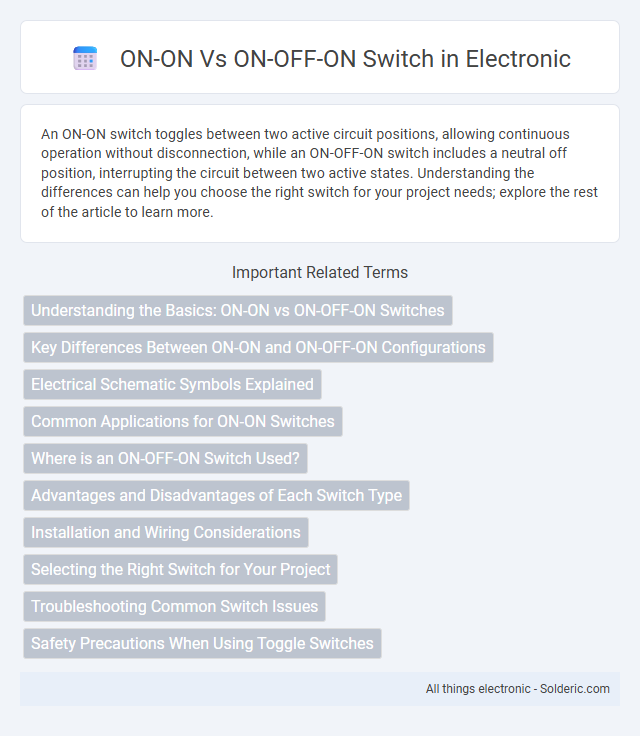An ON-ON switch toggles between two active circuit positions, allowing continuous operation without disconnection, while an ON-OFF-ON switch includes a neutral off position, interrupting the circuit between two active states. Understanding the differences can help you choose the right switch for your project needs; explore the rest of the article to learn more.
Comparison Table
| Feature | ON-ON Switch | ON-OFF-ON Switch |
|---|---|---|
| Positions | 2 (ON and ON) | 3 (ON, OFF, ON) |
| Functionality | Switches between two circuits without off position | Switches between two circuits with an off position in the middle |
| Applications | Audio, lighting, dual-circuit control | Power control, device isolation, multi-mode switching |
| Use Case | Continuous connection, toggling between two active states | Option to disconnect circuit completely between two active states |
| Common Types | SPDT (Single Pole Double Throw) | SPDT with center off position |
Understanding the Basics: ON-ON vs ON-OFF-ON Switches
An ON-ON switch allows You to toggle between two active circuits, providing continuous connection without interruption. In contrast, an ON-OFF-ON switch offers two active positions with an off state in the middle, enabling complete disconnection of the circuit when needed. Choosing between ON-ON and ON-OFF-ON switches depends on whether maintaining constant connectivity or including an off position is critical for Your application.
Key Differences Between ON-ON and ON-OFF-ON Configurations
ON-ON switches allow toggling between two active circuits with no off position, enabling continuous connection in either toggle state. ON-OFF-ON switches feature a center off position that breaks the circuit, offering three distinct states: two active connections plus an isolated off mode. The primary difference lies in the availability of a neutral, non-conductive position in ON-OFF-ON switches, which provides added control for circuit selection and safety.
Electrical Schematic Symbols Explained
ON-ON and ON-OFF-ON switches differ in their electrical schematic symbols, where ON-ON is represented by a double-pole configuration connecting two circuits alternately, and ON-OFF-ON includes a middle position that breaks the circuit, indicated by a center-off symbol. Understanding these symbols is crucial for correctly interpreting circuit diagrams and ensuring your design functions as intended. These schematic icons provide clear visual cues about switch positions and circuit connectivity, aiding efficient troubleshooting and assembly.
Common Applications for ON-ON Switches
ON-ON switches are commonly used in applications where two distinct circuit paths need to be alternated without an off state, such as in audio equipment for selecting between two sound sources or in automotive controls for toggling between different lighting modes. These switches provide reliable and straightforward operation in low-voltage circuits, ideal for device settings that require quick switching between functions. Your choice of an ON-ON switch suits environments demanding continuous connectivity with simple toggling.
Where is an ON-OFF-ON Switch Used?
An ON-OFF-ON switch is commonly used in electronic devices requiring three distinct states, such as selecting different circuit paths or modes of operation. It is prevalent in applications like guitar amplifiers, HVAC controls, and industrial machinery, offering easy toggling between two active settings with a neutral off position. This switch type enhances user control by providing clear separation between operational and inactive modes, improving functionality and safety.
Advantages and Disadvantages of Each Switch Type
ON-ON switches provide simple toggling between two active circuits, offering straightforward control with fewer wiring complexities, ideal for basic device functions where two options suffice. ON-OFF-ON switches add a middle off position, giving greater control by allowing complete disconnection of the circuit, which can prevent power drain or enable safety shutoff but may increase wiring complexity and switch size. Your choice depends on whether you need simple dual-state operation (ON-ON) or a versatile tri-state configuration (ON-OFF-ON) balancing simplicity against functionality.
Installation and Wiring Considerations
ON-ON switches require simpler installation and wiring since they only toggle between two active circuits, minimizing complexity and reducing the potential for wiring errors. ON-OFF-ON switches demand careful attention during installation due to the additional off position, necessitating accurate wiring to ensure the switch properly isolates the circuit when in the off state. Choosing the right switch for your application depends on understanding these distinctions, as improper wiring of an ON-OFF-ON switch can lead to circuit malfunction or safety hazards.
Selecting the Right Switch for Your Project
Choosing between an ON-ON and an ON-OFF-ON switch depends on your project's functional requirements and circuit design. ON-ON switches provide two active positions without an off state, ideal for toggling between two options, while ON-OFF-ON switches add a neutral off position for more control over power flow. Assessing your need for intermediate power disconnection or simple switching will help you select the right switch to optimize your device's performance.
Troubleshooting Common Switch Issues
ON-ON switches provide continuous connection between two circuits, while ON-OFF-ON switches include an intermediate off position, offering greater control but increased complexity. Troubleshooting common issues involves checking for loose contacts, inspecting internal corrosion, and testing continuity with a multimeter to ensure proper switching. Your ability to identify whether the switch operates correctly in each position will help isolate faults and restore reliable functionality.
Safety Precautions When Using Toggle Switches
When using ON-ON and ON-OFF-ON toggle switches, ensure proper insulation to prevent electrical shorts and avoid accidental activation by securing the switch cover. Verify the switch rating matches the load to prevent overheating or circuit damage, and always disconnect power before installation or maintenance. Employing switches with locking mechanisms or protective guards enhances safety by reducing unintended switching.
ON-ON vs ON-OFF-ON switch Infographic

 solderic.com
solderic.com